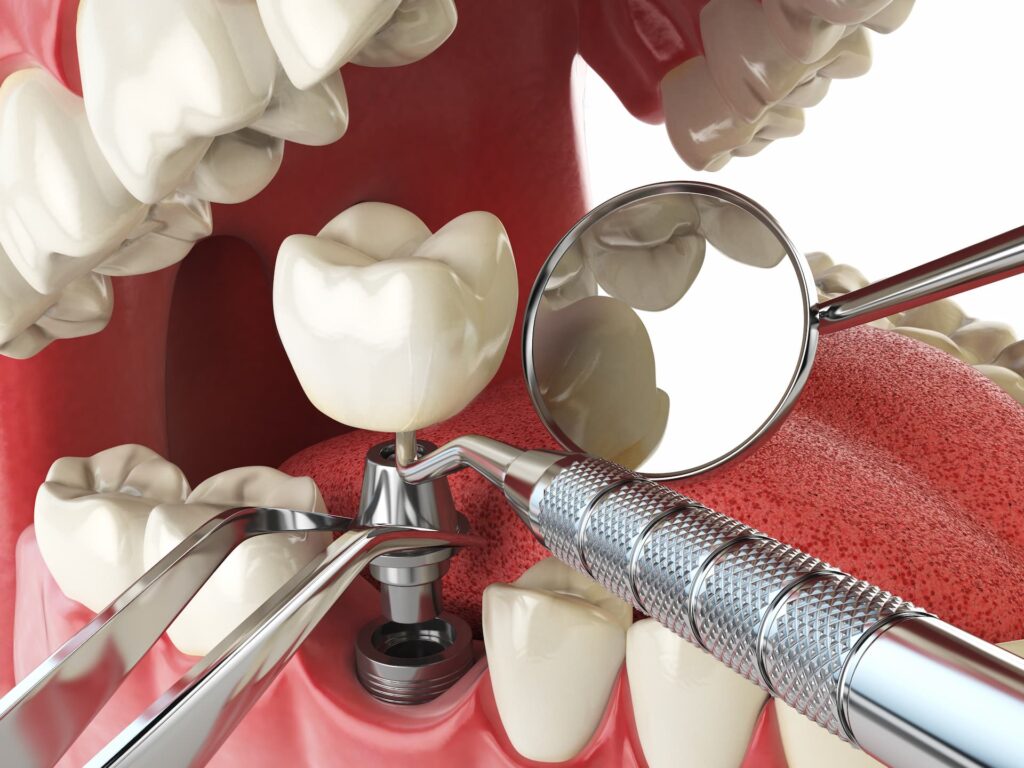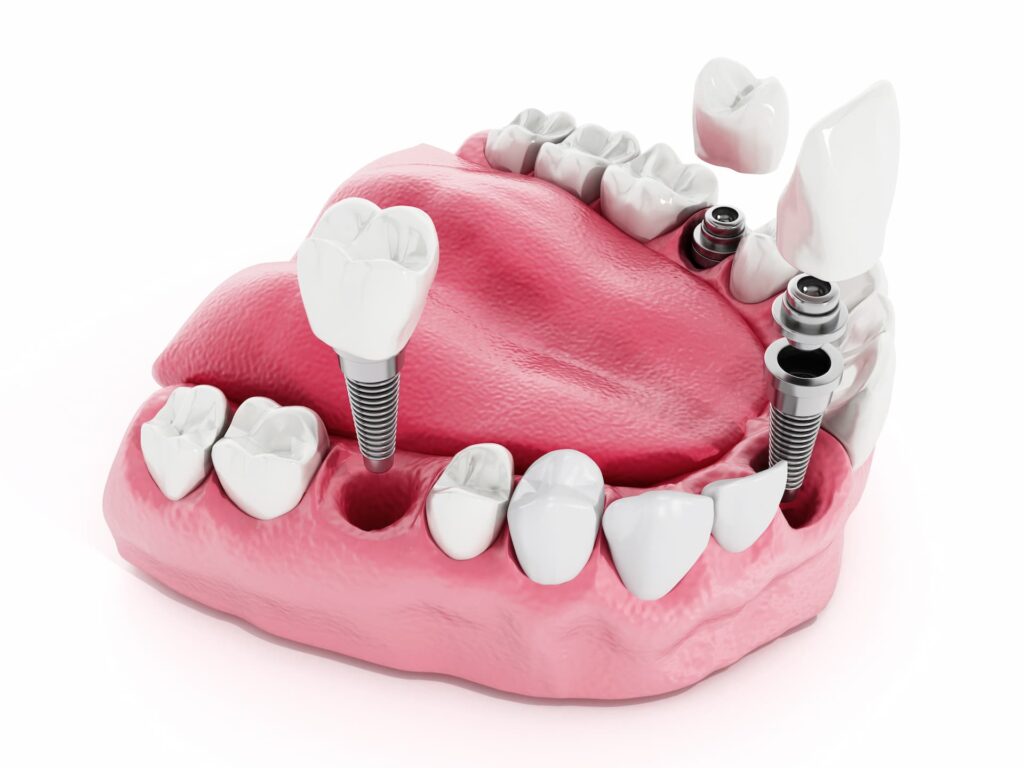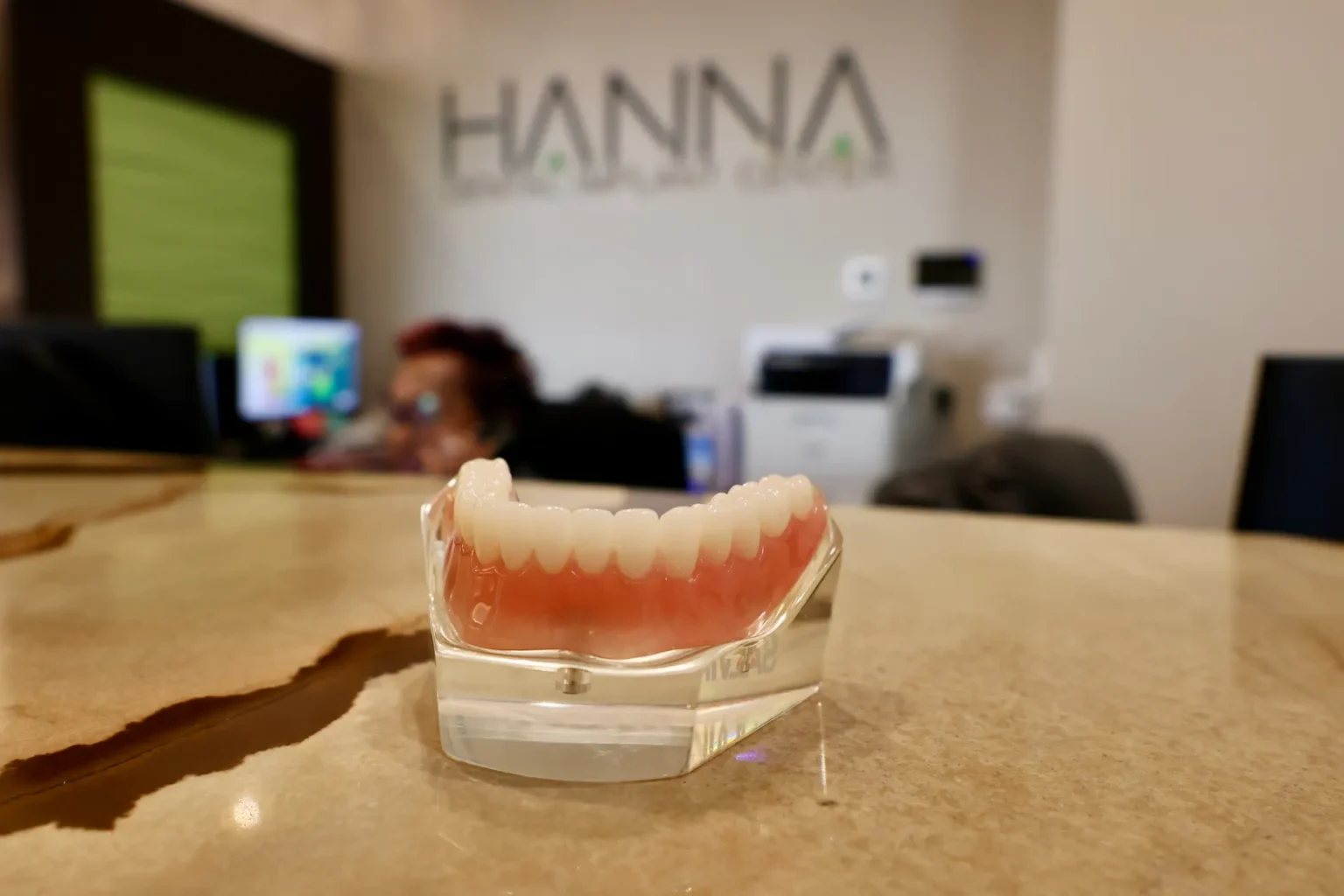Dental implants are a fantastic way to restore your smile and self-confidence. But what are they made of?
In this guide, Hanna Dental will help you understand the different materials used to construct dental implants and why they are so important.
What are Dental Implants Made Of?
Essentially artificial tooth roots, and dental implants are placed into the jawbone, providing a secure base for a replacement tooth or bridge.
This process is referred to as osseointegration, where the implant fuses with the jawbone, forming a strong bond and providing a natural-looking and feeling solution.
Dental implants provide a strong, durable, and long-lasting solution to tooth loss. Unlike dentures, they are a permanent solution that doesn’t need to be removed each night.
In addition, they help prevent bone loss in the jaw, preserve the face’s natural shape, and provide superior comfort and stability compared to dentures.
Am I a Candidate for Dental Implants?
If you are missing one or more teeth, you may be a candidate for dental implants. Your dentist can help you understand if implants are your best option.
Your dentist will evaluate your overall health, jawbone condition, and dental history to determine if you are a good candidate for dental implants.

Materials Used in Dental Implants
There are several different types of materials used in dental implants, each with its own set of advantages and disadvantages. We’ll kick things off with the most common material used, Titanium.
Titanium
Titanium is the metal of choice for dental implants as it is strong, and its properties make it compatible with living bone and tissue.
Titanium is inert, meaning it does not react to its environment and is corrosion-resistant. It has a high strength-to-weight ratio, meaning it is lightweight yet strong.
Titanium is the ideal material for dental implants due to its strength, corrosion resistance, compatibility with the body, and lightweight properties.
Zirconia
Zirconia is a type of ceramic material that is strong, durable, and biocompatible. It is often used in medical devices and dental prostheses because of its impressive properties.
Zirconia is a strong, wear-resistant material that is also highly biocompatible. It can withstand high temperatures, is corrosion-resistant, and is less prone to fracture or breakage than other materials.
Zirconia is often used in dental implants because of its strength and biocompatibility. It helps to securely attach the implant to the jawbone, and its unique properties help to prevent implant failure or fracturing.
The advantages of using zirconia in dental implants include its strength, durability, and biocompatibility. It is also resistant to corrosion and is less prone to fracturing than other materials, making it an ideal choice for dental implants.

Titanium vs Zirconia
| Titanium Dental Implants | Zirconia Dental Implants | |
| Material Properties | Strong, lightweight, biocompatible, corrosion-resistant | High-strength, biocompatible, tooth-colored, fracture-resistant |
| Color | Silver | White |
| Osseointegration | Good | Good |
| Conductivity | High | Low |
| Aesthetics | Not tooth-colored, may show through thin or receding gums | Tooth-colored, may blend in with natural teeth |
| Allergy | Very rare | Very rare |
| Durability | High | High |
| Cost | Lower cost compared to zirconia | Higher cost compared to titanium |
In a 2019 systematic review about the ability of titanium and zirconia to integrate with the surrounding soft and hard tissues, the researchers found that both types of implants had similar levels of integration with the soft tissues, but titanium tended to have a faster initial integration process with the hard tissues.
Overall, the study suggests that both types of implants can be effective options for dental implantation, but careful consideration of these factors is necessary for optimal outcomes.
It is important to note that while both titanium and zirconia dental implants have their advantages and disadvantages, the choice between the two ultimately depends on the specific needs and preferences of the patient, as well as the recommendation of the dentist.
Talk to your dental implant specialist to know which one is best for your needs.
Other materials
Alternative materials such as porcelain and ceramic are increasingly being used in dental implants due to their durability and strength. They are also more aesthetically pleasing than titanium, so they are often used for a more natural-looking crown or bridge on top of the titanium post.
Alternative materials may be used in some cases when titanium is not suitable, such as when there is a risk of an allergic reaction. They may also be used when the patient wants a more natural-looking implant.

Dental Implant Components
Implant post
Dental professionals typically use a titanium implant post to serve as an artificial tooth root when performing dental implant surgery.
The implant post is cylindrical in shape and is composed of titanium, a biocompatible metal that is designed to fuse with the jawbone, providing a stable and secure foundation for a prosthetic tooth.
Usually between 3.5 to 6mm in diameter and 10-16mm in length, the size will depend on the patient’s individual case.
Abutment
A dental implant abutment is the part that connects the implant to the crown or prosthetic
Made of titanium, the abutment is strong and durable and has a shape and size that is tailored to the patient’s mouth.
It is designed to fit the patient’s mouth accurately and to ensure that the crown or prosthetic fits securely and looks natural.
Crown
A crown of a dental implant is a prosthetic device made to resemble a natural tooth and is used to cover a dental implant for cosmetic and structural purposes.
The purpose of a crown of a dental implant is to provide strength and support to the implant and to make it look and feel like a natural tooth. A crown of a dental implant can be made using a variety of materials, including porcelain, metal, or a combination of both
The shape and size of the crown of a dental implant should be designed to perfectly match the shape and size of your natural teeth, allowing it to fit in with your other teeth and blend in with the rest of your smile
Factors Affecting Dental Implant Material Selection
Choosing the right material for your dental implant is an important decision. The type of material used in dental implants will depend on a variety of factors, including your medical history, allergies, and the type of implant you are getting.
Medical history and allergies
Your medical history and allergies are important factors to consider when selecting dental implant material. Some materials may not be suitable for individuals with certain medical conditions.
Certain medical conditions can lead to an allergic reaction or rejection of the material used in your dental implant.
Your dental surgeon will be able to assess your medical history and allergies to determine the best material for your implant.
Examples of medical conditions that may affect dental implant material selection include diabetes, heart disease, autoimmune disorders, and some forms of cancer.
Location of the implant
Dental implants can be placed in different locations in the mouth, such as the upper or lower jaw. The location of the implant can have an effect on the material selection.
For example, implants in the lower jaw may require a more durable material than those in the upper jaw due to the increased forces generated. On the other hand, implants located in the molar and premolar areas in the lower jaw may require more robust materials like titanium, while implants in the anterior teeth may require a more aesthetic material like zirconia.
Patient Preference
The material that is used for a dental implant or a crown is determined by the patient’s individual needs. The dentist takes the patient’s preference into account who will assess the best material for the individual’s particular situation.
Patients may choose a material for aesthetic reasons, such as the color or shape of the implant.
Other factors that may influence a patient’s preference include the cost, the longevity of the implant, the amount of maintenance required, and the level of comfort during the procedure.

Maintaining Your Dental Implant
Caring for your dental implant is relatively straightforward. However, it’s important to maintain a regular dental hygiene routine in order to ensure its longevity.
This includes brushing and flossing your teeth as you normally would and also making sure to visit your dentist at least twice a year for checkups and cleanings.
How often should I visit my dentist after my implant is placed?
It’s important to visit your dentist for regular checkups after your implant has been placed. Your dentist will likely recommend that you visit for follow-up appointments every few months for the first year after your implant is placed to ensure that the implant is settling in properly.
How can I properly care for my dental implant at home?
Maintaining healthy habits is important to keep your dental implant clean and in good condition.
This includes brushing your teeth twice a day with a soft-bristled toothbrush and fluoride toothpaste and flossing between your teeth once a day. It’s also important to avoid foods that are sticky and hard, as these can damage your implant.
What potential complications should I be aware of?
There are a few potential complications that can arise with dental implants. These include infection, nerve damage, and sinus issues. It’s important to talk to your dentist if you experience any of these symptoms, as they can help you to address them.
FAQs
How long is a dental implant procedure?
The length of a dental implant procedure can vary depending on the patient’s particular needs and requirements. Generally, the process can take anywhere from one to two hours and may require multiple visits.
How many teeth do you get with implants?
The number of teeth you can get with implants depends on the individual case. Generally, dental implants can be used to replace one or more teeth, depending on the patient’s needs.
Can tooth extraction and implant be done at the same time?
Yes, in certain cases, it is possible to complete both tooth extraction and implantation in a single visit. However, this depends on the individual case and the complexity of the procedure.
Conclusion
Dental implants are a great option for tooth replacement as they offer a permanent solution to missing teeth. They are designed to look and feel like natural teeth, allowing you to confidently go about your daily life. They are also designed to last many years, making them a great long-term investment for oral health.
If you are interested in getting a dental implant, the first step is to schedule a consultation with a qualified dentist.
During the consultation, the dentist will assess your oral health and discuss the different types of implants available and the procedure required to place the implant. They will then provide you with a treatment plan that outlines the cost and timeline for the implant.



